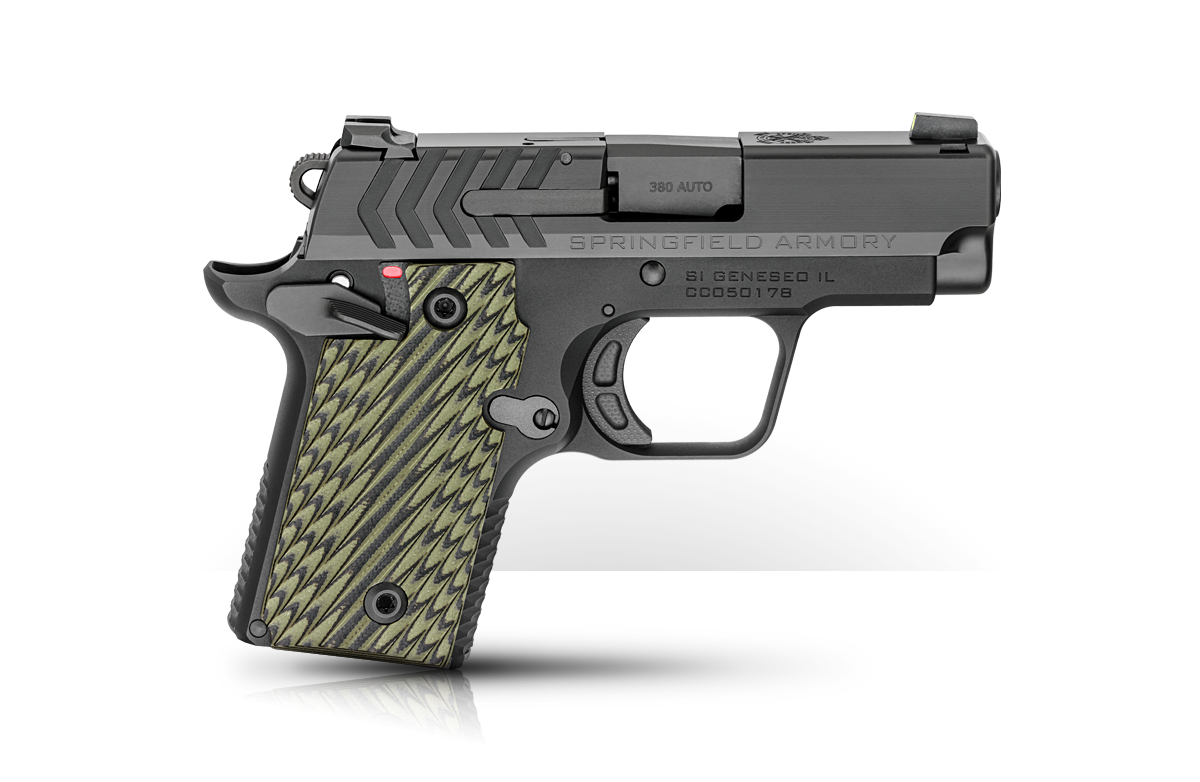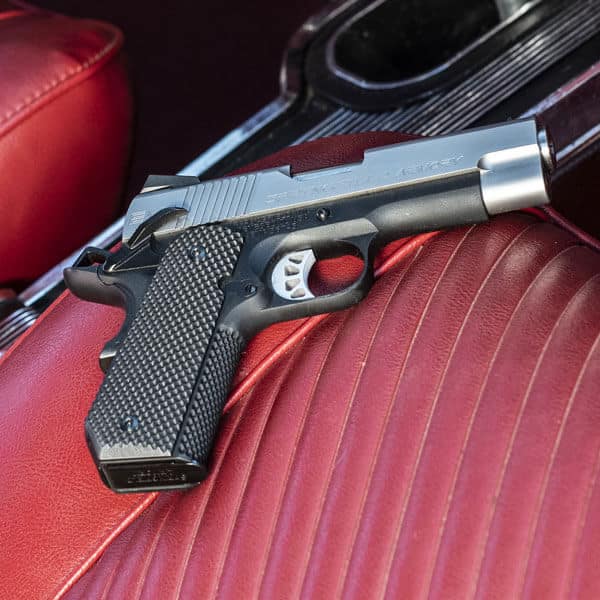Review: Springfield Armory 911
February 1st, 2020
9 minute read
Most people who regularly carry a handgun for self-defense choose a small, light handgun that is easily concealable — and gun manufacturers know it. If you took a bunch of experts and told them to design a subcompact .380 ACP 1911 with all of the best features they could think of, I’m not sure if the end result would be any different than the Springfield Armory 911. In fact, Springfield believes the 911 is the perfect pistol for everyday carry. Those are some big words for such a small gun.
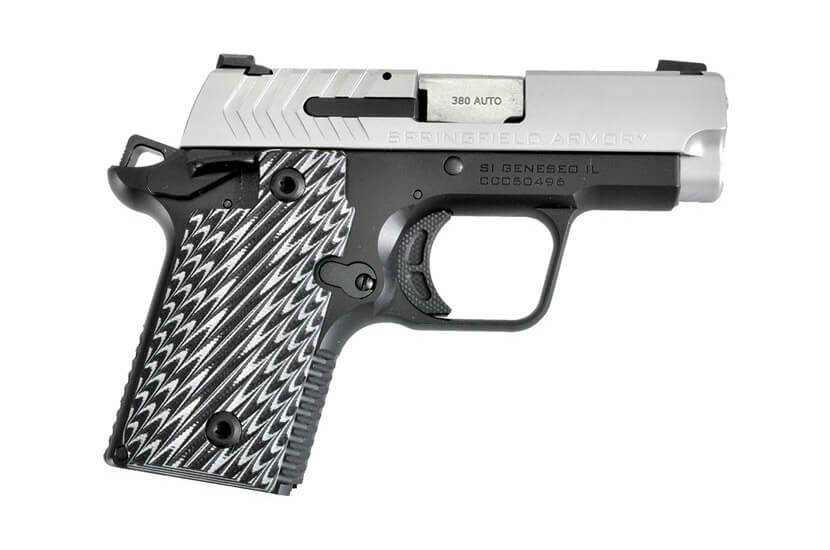
Let’s look at the 911 and see if it measures up. First, this is a small gun. It has been shrunk in every way to fit the .380 ACP cartridge. It sports a 2.7-inch barrel, and overall it’s 5.5 inches long by 3.9 inches tall. It is also flat, less than an inch thick at the grips.
Springfield’s specs have the gun’s weight as 12.6 ounces with an unloaded magazine in place. So it’s both small and light enough to conceal in a pocket. The 911 ships with one flush six-round stainless steel magazine and one longer seven-round magazine with a polymer grip extension.
There are two versions of this pistol, the only difference being the finish on the slide/barrel. For testing, Springfield Armory shipped me a two-tone sample. By the time you read this, two additional versions of the 911, with Viridian laser grips, should be available.
This is an all-metal pistol, but it’s about as corrosion resistant as you can get. First, both the slide and barrel are stainless steel. On the all-black pistol, the stainless-steel slide and barrel are coated with black nitride. The frame is 7075 aluminum for both weight savings and imperviousness to rust.
Interestingly, the trigger is made of G10 — the same composite laminate material as the grips. I don’t know if it provides any weight savings over aluminum, but I like that the people putting this pistol together were thinking outside the box, and it sets this pistol apart from the competition. All the G10 parts — trigger, mainspring housing and grips — are made by Hogue.
Springfield Armory is far from the first company to introduce a .380 1911, but it is the totality of features on the 911 that shows me the company was trying to ensure its pistol was all it could be.
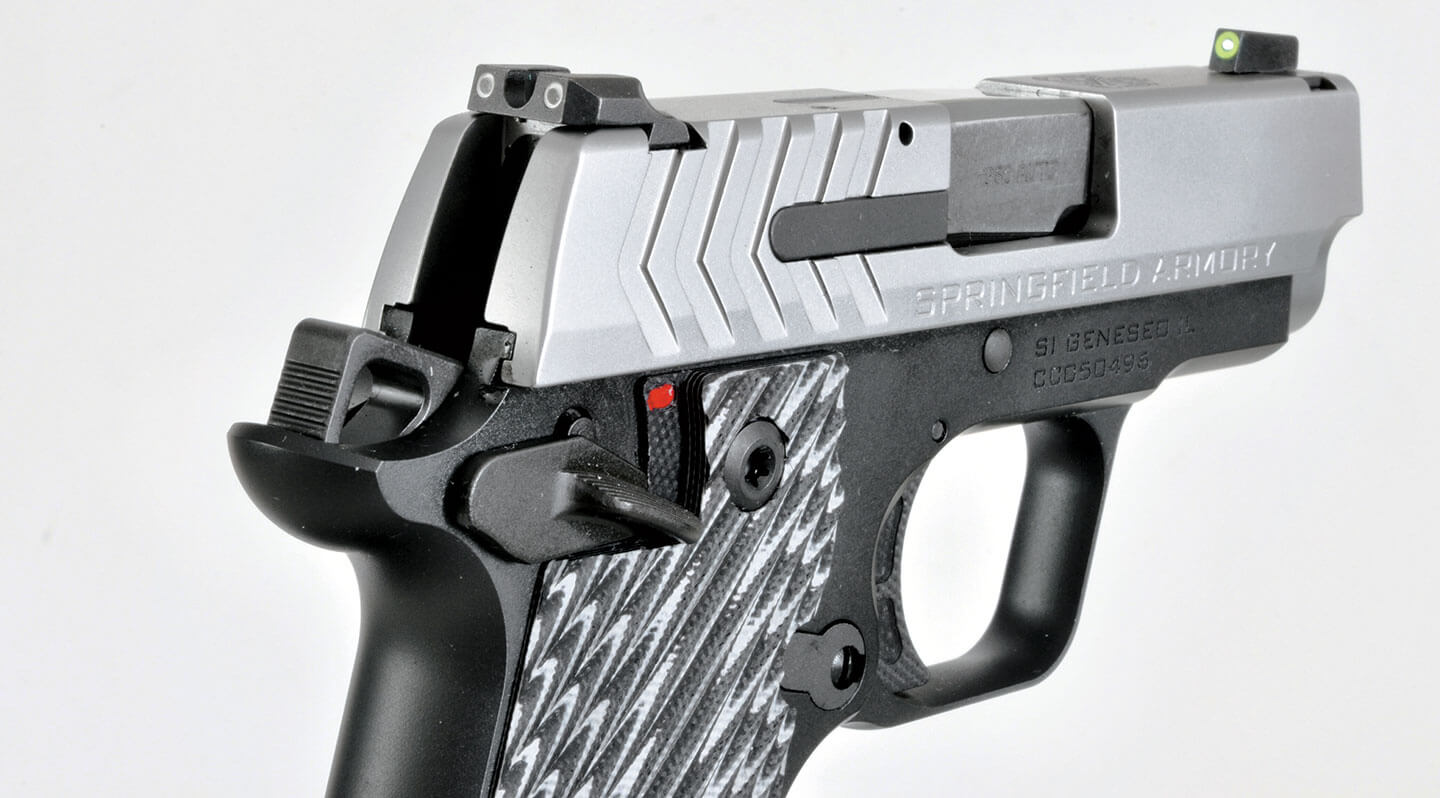
For starters, the sights are top-of-the-line AmeriGlo Pro-Glo night sights. The rear sight has tritium inserts with white outlines to either side of the U-shaped notch, and the front of the rear sight has a ledge, albeit a tiny one, to assist with racking it one-handed on a hard surface.
The big front sight has a tritium insert with a fluorescent yellow/green ring around it. The green ring is made of photoluminescent paint, and if you go from direct sunlight into a dark room (or hit the front sight with the beam of your flashlight for just a few seconds), the green ring will light up like an alien’s eye in a sci-fi movie.
These sights are better “combat” sights than those found on 90 percent of full-size guns from any manufacturer (including Springfield) and hugely increase the functionality of this pistol.
At the top of the slide is a loaded-chamber indicator in the form of a pivoting lever. The pistol sports a full-length recoil spring guide rod with a flat-wire recoil spring.
Unlike a full-size 1911, this pistol does not have a grip safety. It does have a firing-pin safety, but it is not a Series 80 style with extra parts messing with the quality of the trigger pull.
The frontstrap of the frame and the mainspring housing feature Springfield’s Octo-Grip texturing, which to me looks like some sort of fencing. It is not as aggressive as checkering, but it works to keep your hand in place, especially with the undercut trigger guard. Also helping to keep your hand in place are the aggressively textured and stylish black-and-white grips. On the all-black 911 the grips are green and black.
The distance from the bottom of the trigger guard to the bottom of the frame is just a hair over an inch and a half, which means that with the flush magazine in place you won’t be able to get more than two fingers on the grip. The longer magazine with grip extension adds more than a half-inch of additional real estate and will enable most people to get their whole hand on the gun.
The magazine well opening in the frame is beveled, which is a nice touch, but if you find yourself having to reload in the middle of a gunfight and all you have with you is a subcompact pistol…well, I think that’s the dictionary definition of a very bad day.
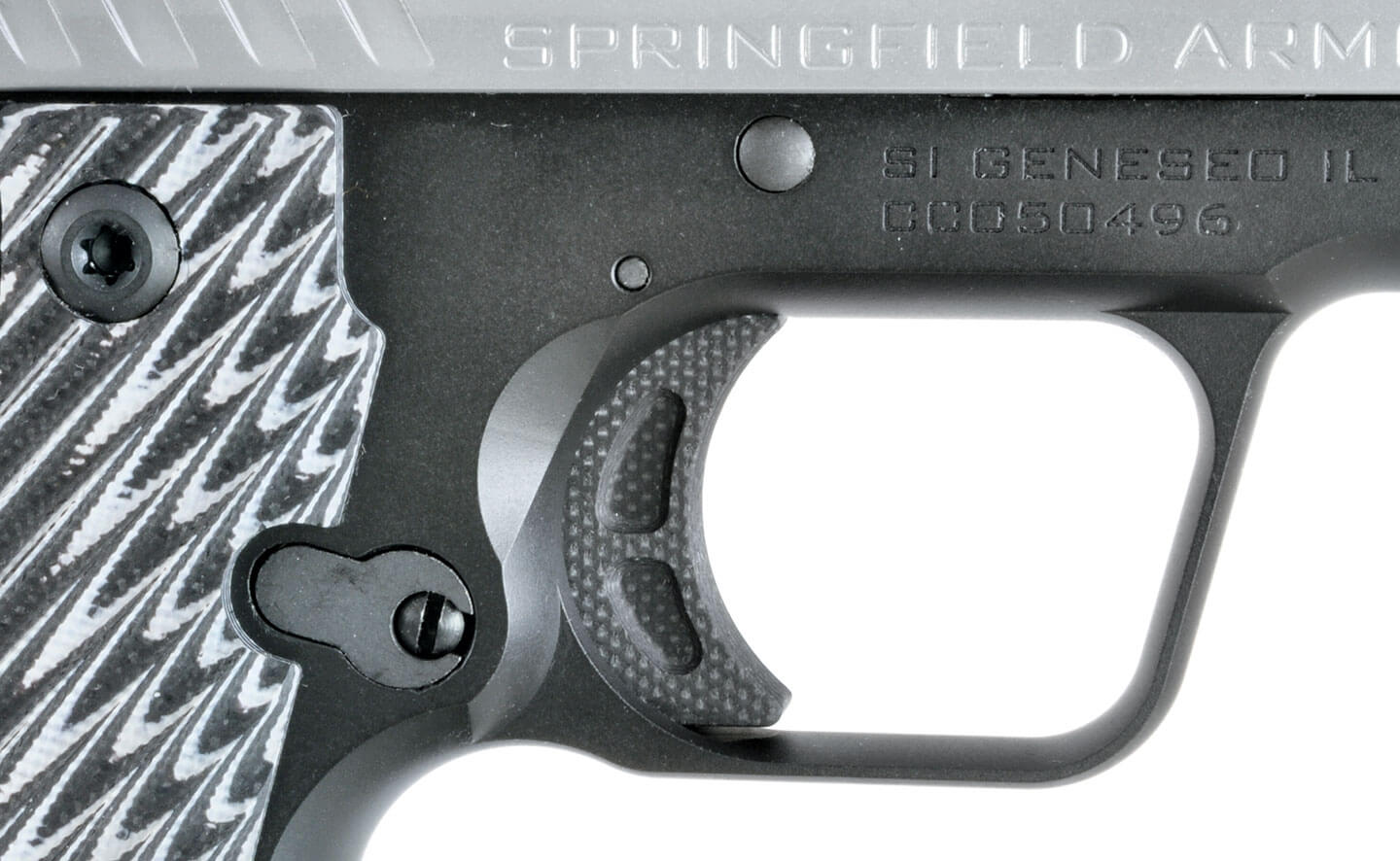
The advertised trigger pull on the 911 is five pounds. Trigger pull on my sample was 6.5 pounds, but it truly feels closer to the advertised spec because it is so short and crisp.
The ambidextrous thumb safety lever clicks when moving it in both directions. Unlike a traditional 1911, you can activate the thumb safety when the hammer is down. You don’t need to, and I’m not sure why you’d ever want to. When the hammer is down on a single-action-only pistol, pulling the trigger gets you nothing. With the safety engaged you cannot cock the hammer or work the slide.
With the hammer cocked it takes little effort to work the slide on this pistol. It is actually harder to cock the hammer than it is to cycle the slide once the hammer is back. One of the advantages of a .380 ACP over small guns chambered in 9mm is the lighter recoil spring. It takes much less force to chamber the first round, which is important if your grip strength is lacking.
Note that you can get a 911 in 9mm if you prefer the extra punch that those defensive rounds seem to offer. Check out Dan Abraham’s 911 review for more information.
Springfield Armory first rolled out these pistols last fall, giving a number of gun writers a sneak preview and a chance to put as many rounds downrange through these guns as we wanted. Each of us was given a pistol and a bucket of ammo. Seriously, an actual bucket. We also used the guns in a competition later in the day, where we burned through even more ammo.
I’m not sure how many rounds I fired through these little .380s, but it had to be close to 200 rounds — if not more. Multiply that by 12 or so fellow shooters and you’re talking a lot of ammo. I don’t remember experiencing a malfunction or seeing anyone else have one.
In all honesty, 200 rounds is more ammo than a lot of owners will put through their subcompact carry gun in a lifetime. Most subcompact pistols are bought to carry, not to shoot. But of all the pistols Springfield was introducing at the event, we all shot the 911 more than any of the others. Why? Because it’s comfortable and we all liked it.
Despite the fact that the 911 is small, it doesn’t hurt to shoot, even when using the flush magazine. This is rare for a subcompact pistol. And when you combine the 911’s low bore, good trigger and great sights with the .380’s minimal recoil, it’s easy to put bullets where you want them to go.
Springfield invited Action Target to the event, and we shot some of the company’s new reactive paper targets. Even though the 911 is a tiny gun, I was able to get head shots at five yards on multiple targets as fast as I could pull the trigger. It was neat watching paper targets drop like steel plates and then reset.
This is a fun pistol to shoot. With the longer, grip-extension magazine in place, it was a little more comfortable to shoot, but even with the flush magazine in place, the pistol felt good in my hand. Between the flat profile and aggressive grips and Octo-Grip frame texturing, it doesn’t move in your hand while you’re shooting.
It’s odd, but due to the combination of ergonomics and “grown-up” features, the 911 seems like a bigger pistol than it actually is. When I lay my trigger finger along the side of the gun and see that it reaches almost to the end of the frame, I’m surprised every time.
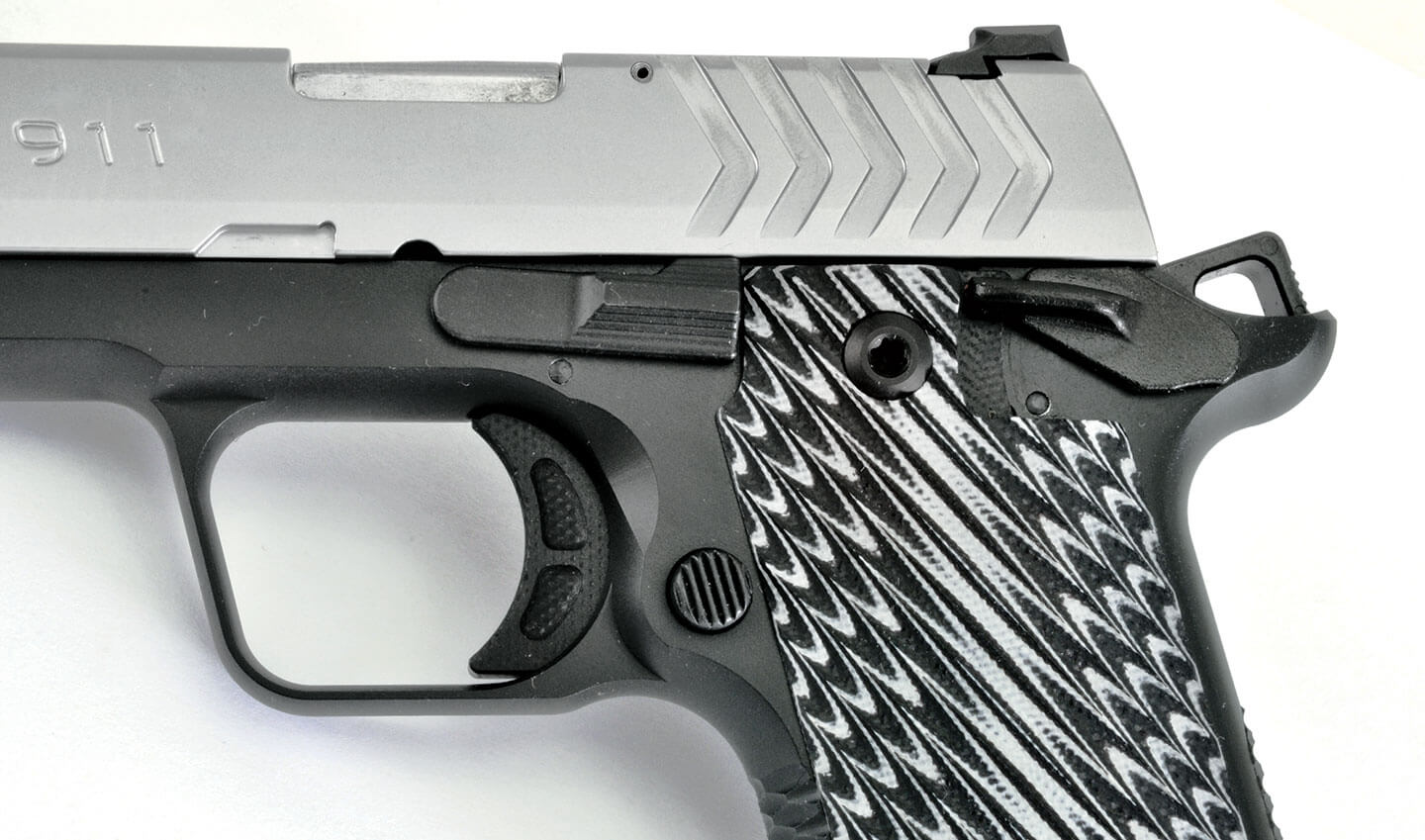
I have only one real complaint about the 911, and that is with the thumb safety. While I wish the safety lever was both longer and wider, I will admit I didn’t have any problem working it up and down with the side of my thumb. However, with the thumb safety of the 911 up/engaged, the lever is positioned right where the safety on a standard 1911 would be when it is off/disengaged. To disengage it you have to push it down even farther.
If you’ve got any time behind a 1911, the muscle memory feel of the 911’s safety under your thumb will be telling your brain it is off, when in reality it is still on. This happened to me several times.
Now, if you just finished reading that paragraph and aren’t concerned because you don’t plan on carrying this pistol cocked for whatever reason, I ask you to please stop reading this article and go buy yourself a nice snubnose revolver or double-action-only semiauto.
Off-body carry in a purse or bag or briefcase is one thing, but if you’re carrying a pistol on your person, choosing to carry a pistol in such a manner that you can’t draw and fire it with one hand in one smooth motion is just dumb. I don’t know any other nicer word for it.
Don’t choose to carry a handgun in such a condition that you have to cock the hammer or rack a round into the chamber before you can shoot. In effect, it is no different than carrying a pistol without a loaded magazine inserted. If you’re going to carry the 911, carry it cocked-and-locked or carry something else.
The 911 is sold with a little nylon carrying case with an internal rubberized holster. The holster is mounted on a Velcro strip, so its position is adjustable. Opposite the holster on the inside is a windowed slot, presumably to house your CCW card.
This wouldn’t be an honest review without addressing the observation that the 911 is simply Springfield Armory’s version of the SIG P238. The guns are similar in appearance, function and size. While currently the P238 is available in more variations, when comparing the base versions of the 911 and the P238, the 911 is 2.5 ounces lighter and $80 cheaper and has better sights and better grips.

First Response
The tagline for the 911 is: “When you have to be your own first responder.” I’ve written previously that cops and firemen and EMTs arrive only after they’ve been called and really are the second responders. The true first responder is the person or persons who are there when an incident necessitating the need for self-defense occurs.
Some people feel the .380 is too weak to be suitable for self-defense, but this is not 1985. The improvements in projectiles haven’t happened in a vacuum, and the performance of modern .380 bullets is as vastly improved as those in 9mm, .40 and .45 ACP.
Caliber aside, as for the 911 being small and therefore not a good choice for self-defense, I disagree. I consider being able to hit the target fast and repeatedly more important than caliber. Shot placement is far more important than caliber. For that reason, I would choose to carry the 911 over any revolver of any size in any caliber because I can shoot it faster and more accurately.
Springfield Armory 911
Type: Single-action semiauto
Caliber: .380 ACP
Capacity: 6
Barrel: 2.7 in.
Weight: 12.6 oz.
OAL/Height/Width: 5.5/3.9/1.1 in.
Construction: stainless steel slide, anodized aluminum frame
Finish: polished stainless (as tested)
Grips: G10 composite
Sights: AmeriGlo Pro-Glo night sights
Trigger: 6.5 lb. pull (measured)
Safeties: thumb, firing pin
Price: $599
Manufacturer: Springfield Armory
Editor’s Notes:
This article was written by James Tarr and shared with us by Handguns Magazine. The original article can be viewed here.
Please be sure to check out the new The Armory Life forum, where you can comment about our daily articles, as well as just talk guns and gear. Click the “Go To Forum Thread” link below to jump in!
Join the Discussion
Featured in this article
Continue Reading
Did you enjoy this article?

 58
58




